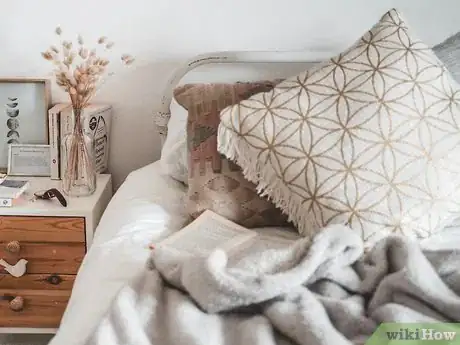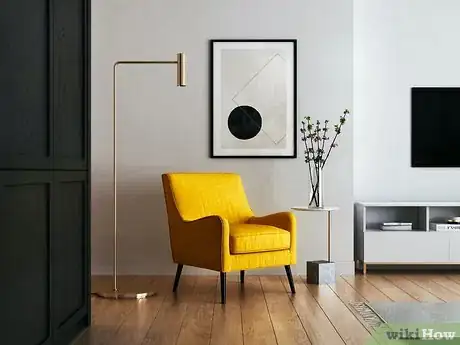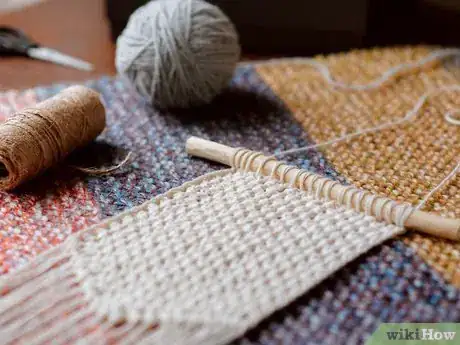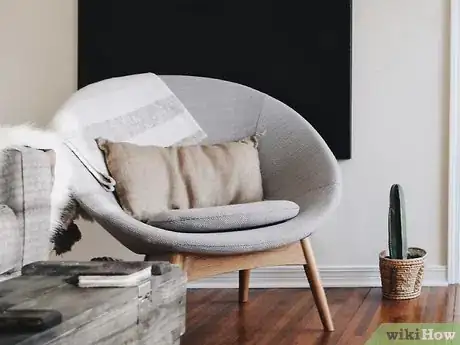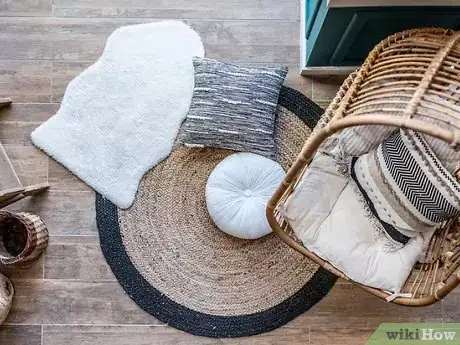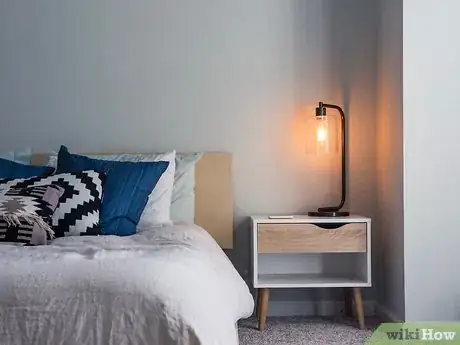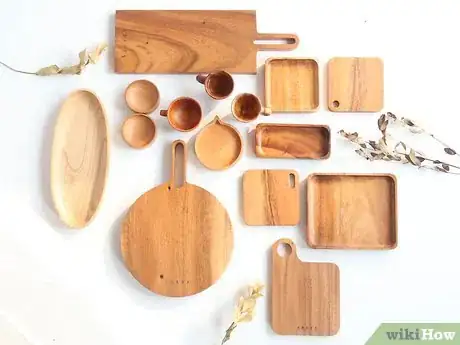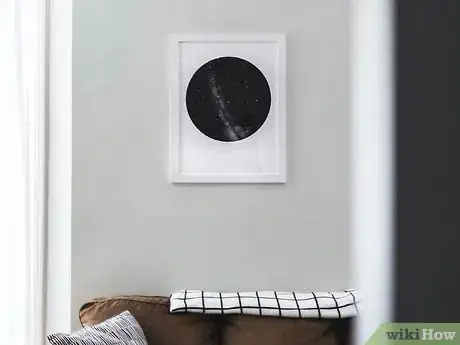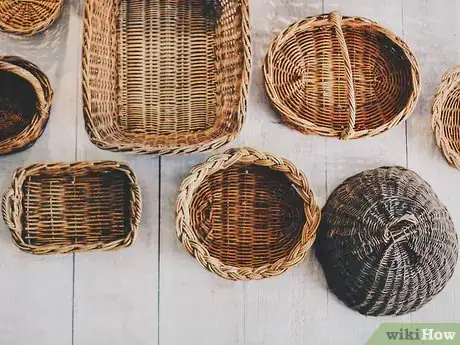This article was co-authored by Garrison Hullinger and by wikiHow staff writer, Danielle Blinka, MA, MPA. Garrison Hullinger is an Interior Designer and the President of Garrison Hullinger Interior Design (GHID). With more than 15 years of experience, he specializes in client-centered design that balances beauty and warmth with comfort and functionality. Garrison and GHID’s work has been featured in numerous publications such as The New York Times, The Wall Street Journal, and Interior Design Magazine. Garrison attended Oklahoma Christian University.
This article has been viewed 8,795 times.
If you want a comfy, relaxing space, Japandi style is the way to go. Japandi style marries rustic, “hygge”—which means cozy—Scandinavian decor with minimalist, “wabi-sabi”—which means imperfect—Japanese design. This style combines muted colors and natural items for a warm, curated look. Your goal is to create a space that’s eco-friendly, comfortable, and functional, without a lot of clutter. Fortunately, it’s a fairly easy look to create, and we’ve compiled a list of tips to help you design your perfect room.
Steps
Choose a warm, neutral color palette.
-
Go with shades of white, beige, grey, brown, or pale green. Select a few shades that work together to use for your entire room. If you’re leaning more minimalist, stick to a monochromatic look by selecting shades of just one color.[1] X Research source Here are some color combos you might try:
- White, pale grey, and tan.
- Beige, tan, and a rusty reddish brown.
- White, pale grey, and pale green.
- Beige, tan, and light brown.
Incorporate one darker color to create contrast.
-
Both Scandinavian and Japanese design accent with contrasting colors. To find your contrasting color, choose a dark shade that balances your color palette. In general, stick to neutrals like black, charcoal grey, and rich browns. Then, paint an accent wall in your room the contrasting color or pick a large piece of furniture that's the color you want. Alternatively, hang wall art in your contrasting color.[2] X Research source
- Black is the most common contrasting color, but you can also use charcoal or slate grey or a rich, chocolate brown.
- For example, you might paint three walls of your room white and the fourth wall black.
- On the other hand, you could paint your entire room white and then hang a large charcoal grey painting on one wall.
Add textured pieces to warm up your space.
-
Texture adds visual interest and coziness without creating clutter. Since Japandi style leans minimalist, texture is your bestie! Look for textured rugs, wall hangings, and decorative items. Incorporate a few pieces to elevate the style in your room.[3] X Research source Here are some ideas:
- Create an accent wall with bamboo rods, grey tiles, or shellac.
- To warm up a bare wall, hang macrame, a tapestry, or a textured painting.
- When it comes to rugs, look for a rattan, faux fur, or bamboo rug.
- For decorative items, you could choose a textured clay vase, a burlap pillow, a woven tray, or a wicker basket.
Select furniture that has a low profile and clean lines.
-
Japandi style has a modern, minimalist feel. Pick furniture that has straight lines and sharp angles, like Mid Century modern or minimalist Japanese designs. Additionally, look for pieces that have a wooden base to capture the natural aesthetic of Japandi style.[4] X Research source Here are some ideas for each room:
- In a bedroom, you might pick a platform bed, low night stands, and a short, plain dresser.
- For your living room, short, rectangular seating is a sure-fire winner. Mid Century modern designs are an easy way to create a Japandi look. For your coffee table, go with a round design if you want a cozier feel or a rectangular style if you lean more minimalist.
- In your kitchen, try a rustic dinner table, like reclaimed wood. You could also go with something modern and sleek. Try pairing a wooden table with upholstered chairs to really get that cozy-meets-minimal feel.
- In your bathroom, pick a bamboo or wicker storage cabinet.
Include multi-functional pieces as needed.
-
Japandi style is all about functionality, so your pieces need purpose. While most of your things will have one use, choosing some multi-purpose items helps keep your minimalist vibe.[5] X Research source Here are some ways you can incorporate more functionality:
- Pick a coffee or end table that offers storage or that turns into a desk.
- Get a bed with drawers built into it for storage.
- Choose a couch that folds out into a bed.
- Get a desk with a built-in bookshelf.
- Use your dishes as decorations.
Accent your furniture with a cozy throw and pillows.
-
Blankets and pillows capture the Scandinavian side of Japandi style. Pick soft, thick blankets that feel cozy and warm. When it comes to pillows, layer different sizes, colors and styles. Just make sure you stick to your muted color palette.[6] X Research source You might try these arrangements:
- Drape a white faux fur blanket over your sofa. Then, arrange a few pale grey square pillows and a round dark grey pillow across the seat.
- Fold a chunky grey blanket and place it along the back of your sofa. Next, place a few white throw pillows along the back of the seat. Finally, incorporate an accent color, like rust or mustard yellow, in another accent pillow.
Lay a cozy or textured rug to warm up the space.
-
A cozy rug leans more Scandinavian, while a textured rug is more Japanese. Choose a faux fur, plush, or a chunky knit rug for a warm, comfy feel. Alternatively, go with a bamboo, woven, or jute rug for a natural vibe. You could even layer your rugs to create more texture in your room.[7] X Research source
- If you want a more minimalist look, you might put down a sleek bamboo rug or a woven rug made from natural fibers.
- For a cozier look, go with a lush rug, like faux fur or wool rug.
- If you want to layer your rugs, you might put down a basic bamboo rug first. Then lay one or two cozier rugs over it.
Add lighting with a modern or Japanese-style lamp.
-
Use lamps to balance out the light in your room. Mid Century modern styles are sleek and minimalist, so they fit right into Japandi style. On the other hand, triangular or round Japanese lampshades are perfect for creating a cozy-yet-minimalist vibe.[8] X Research source
- Large Japanese lamp shades work well for floor lamps or overhead lighting. However, a large mid-mod lamp can add more light without taking up as much space.
- For table lamps, go with a sleek mid-mod metal lamp.
Add a few indoor plants.
-
Japandi style is all about natural elements, so you need some plants. Any size plant will look great in your space. Go with a floor plant if you want it to be a focal point in your home, or add smaller plants on tables or shelving to add a touch of nature. Remember to check the care instructions for your plants so they stay alive.[9] X Research source
- Great options include bamboo, bonsai, air plants, palms, ivy, snake plants, succulents, aloe, and potted trees. However, any plant will look great!
- Caring for plants not your thing? Try dried branches or flowers instead.[10] X Research source
Limit your decorations to a few well-loved, functional items.
-
Less is more when it comes to Japandi style. While it’s not totally minimalistic, you don’t want a lot of clutter out. Pick out your favorite items to have on display. These can be items you’re using or things you just find beautiful.[11] X Research source
- On your coffee table, you could arrange a vase of dried flowers, a small serving tray, and a few books.
- On an end table or storage cabinet, you might put a potted plant, a small bust, and a clay bowl to hold small items, like your keys.
- In your bedroom, you could place a potted plant, a jewelry box or dish, and a small photograph on your dresser.
- In the kitchen, you might display your dishes as decor or a large vase of dried stems or flowers.
Decorate with items made from organic or natural materials.
-
Natural elements tie Japanese and Scandinavian style together. Fortunately, it’s easy to bring nature into your home. In addition to plants, materials like wood, fibers, grass, shells, antlers, and rocks all add to your Japandi vibe.[12] X Research source Here are some style choices you might try:
- Use natural wood bowls in your kitchen, which can double as decorations.
- Get a carved wooden vase.
- Protect your tables with coasters made from sliced wood.
- Hang a set of reclaimed antlers on your wall.
- Get a reclaimed wood table.
- Decorate with shells or stones.
- Use woven storage bins to hold items like extra blankets or books.
Incorporate a burst of geometric or playful pattern.
-
A little bit of pattern makes your room feel cozier. Pick a geometric pattern for a more traditional look. Alternatively, look for a quirky pattern if you want a unique vibe. Feature the pattern on a piece of art, a pillow, a blanket, or an item on display.[13] X Research source You could try the following:
- Get a painting or throw pillow that has a white background with a pattern of black dashes or black triangles.
- Display a vase or teapot that has a yellow zigzag pattern.
- Incorporate a throw pillow that has a ditsy flower print.
Incorporate wicker baskets and storage to hide clutter.
-
Japandi style is quite minimalist, so you don’t want clutter. Instead, hide away items you aren’t using. Arrange a few baskets around your home to hold items you use often. If you have a lot of stuff to store, get a storage cube and baskets to hide away your items. These can include wicker baskets or baskets that match your color scheme.[14] X Research source
- In your living room, use wicker baskets for things like throw blankets, magazines, or children’s toys.
- In your bedroom, use wicker baskets for an extra blanket, dirty clothes, or accessories.
- In your bathroom, wicker baskets might hold extra toilet paper, towels, or dirty clothes.
Choose sustainable, eco-friendly items for your space.
-
Scandinavian and Japanese styles are both environmentally-friendly. Similarly, seek out eco-friendly brands for your decor. You might even thrift or recycle pieces to reduce your footprint. Additionally, you can use found natural items, as well.[15] X Research source
- Look for items at second-hand shops or online.
- Bring natural items indoors. If you go hiking, look for antlers shed by deer, or feathers you could display in a vase. On the beach, collect shells to keep in a bowl or on a shelf.
- Research a company before ordering from them to make sure they’re eco-friendly.
Place your self-care items where they’re easy to use.
-
Live out your most “hygge” life by keeping cozy. Make your self-care routine a part of your decor. Keep the items you use to feel good within easy reach.[16] X Research source Here are some ideas you could try:
- Keep your fuzzy slippers at the end of your bed so you can easily slip into them.
- Put an aromatherapy roller on your nightstand.
- Keep your lotion in a decorative bottle on the sink.
- Leave the book you’re reading out on the coffee table.
You Might Also Like




 The 11 Best Ways to Soundproof Your Bedroom
The 11 Best Ways to Soundproof Your Bedroom

 How to Create a Kawaii Room
How to Create a Kawaii Room





References
- ↑ https://amazingarchitecture.com/articles/essentials-of-japandi-style-making-your-home-a-sanctuary
- ↑ https://www.dwell.com/guide/japandi-home-design-1f14fc77
- ↑ https://www.dwell.com/guide/japandi-home-design-1f14fc77
- ↑ https://www.dezeen.com/2021/07/24/ten-elegant-living-rooms-japandi-interior-design-lookbook/
- ↑ https://homeaddict.io/easy-ways-to-create-japandi-style-in-your-home/
- ↑ https://www.dezeen.com/2021/07/24/ten-elegant-living-rooms-japandi-interior-design-lookbook/
- ↑ https://amazingarchitecture.com/articles/essentials-of-japandi-style-making-your-home-a-sanctuary
- ↑ https://www.dezeen.com/2021/07/24/ten-elegant-living-rooms-japandi-interior-design-lookbook/
- ↑ https://homeaddict.io/easy-ways-to-create-japandi-style-in-your-home/
- ↑ https://www.dezeen.com/2021/07/24/ten-elegant-living-rooms-japandi-interior-design-lookbook/
- ↑ https://www.dwell.com/guide/japandi-home-design-1f14fc77
- ↑ https://homeaddict.io/easy-ways-to-create-japandi-style-in-your-home/
- ↑ https://www.dwell.com/guide/japandi-home-design-1f14fc77
- ↑ https://homeaddict.io/easy-ways-to-create-japandi-style-in-your-home/
- ↑ https://homeaddict.io/easy-ways-to-create-japandi-style-in-your-home/8/
- ↑ https://homeaddict.io/easy-ways-to-create-japandi-style-in-your-home/15/
About This Article

